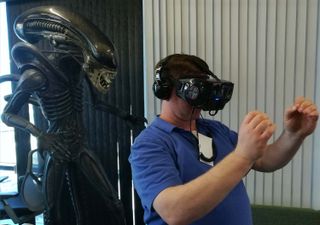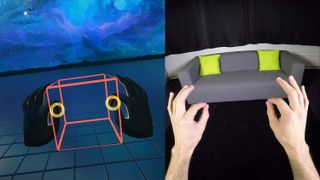Qualcomm's VR Headset Turned My Hands Into Controllers
We try out a Snapdragon 835-powered VR headset that also features built-in support for Leap Motion's gesture control technology.
When we head into virtual worlds these days, we generally want to take our hands and legs with us. And we want to them to work in virtual reality much like they do in the real world.

With that in mind, Qualcomm has built a VR headset reference design that's based around its Snapdragon 835 mobile platform and that incorporates the gesture control technology developed by Leap Motion. Qualcomm introduced the reference design last month, but I got the chance for a quite literal hands-on demo during a visit to the company's San Diego headquarters for a closer look at the Snapdragon 835.
As far as VR demos go, this one was not particularly complex. When I strapped on the Qualcomm VR headset and held up my hands in front of my face, virtual versions appeared in my field of view. The hands looked pretty alien with long, slender fingers, but they mirrored the exact motions that my real hands were making.
When I strapped on the Qualcomm VR headset and held up my hands in front of my face, virtual versions appeared in my field of view.
And that's important, because my virtual hands could manipulate objects. When I held my hands together and made an outward pinching motion, I could create a shape that expanded the further i pulled my hands apart. When I was done forming the shape, I could grip in one or both hands and toss it with a simple throwing motion; the object would fly off into the virtual world, leaving a satisfying splash of color wherever it landed. If I wanted to try a different shape, all I had to do was open my left palm and select from the cube, rectangle and geodesic sphere options.

The entire experience was not unlike my time at February's Mobile World Congress, where I tied a couple of HTC Vive Trackers to my boots to give myself a pair of virtual legs that I could use to fend off some rather angry dinosaurs.
There is one key difference between the two demos, though. HTC's headset is still wired and relies on external sensors to track your virtual comings and goings. The Qualcomm headset is a self-contained unit that promises six degrees of freedom, meaning you can move freely in any direction. I found that out first hand in a separate demo that served as a promotional video for the upcoming Power Rangers movie. The demo let me move freely around the Power Rangers' cave-based headquarters, and when I took off the headset, I found that I had strolled halfway across a Qualcomm work space.
This isn't the first time I've tried out a Qualcomm headset, though that earlier reference design was based on the Snapdragon 820 mobile platform. This new version relies on the Snapdragon 835, which counts immersive experiences as one of it central pillars. The Snapdragon 835 promises to render graphics 25 percent faster than the 820 did, eliminating graphics lag when you turn to look elsewhere in a virtual setting. Qualcomm's also put out a Snapdragon VR developer kit that aims to help content creators leverage the technology in the Snapdragon 835.
- HTC Vive Tracker Brings Bats, Guns and Firehoses Into VR
- 11 Cheap VR Headsets Ranked from Best to Worst
- Meta 2 is the Augmented Reality of Tomorrow, Today
Sign up to get the BEST of Tom’s Guide direct to your inbox.
Upgrade your life with a daily dose of the biggest tech news, lifestyle hacks and our curated analysis. Be the first to know about cutting-edge gadgets and the hottest deals.
Philip Michaels is a Managing Editor at Tom's Guide. He's been covering personal technology since 1999 and was in the building when Steve Jobs showed off the iPhone for the first time. He's been evaluating smartphones since that first iPhone debuted in 2007, and he's been following phone carriers and smartphone plans since 2015. He has strong opinions about Apple, the Oakland Athletics, old movies and proper butchery techniques. Follow him at @PhilipMichaels.

